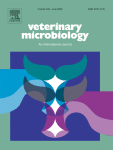Ver ítem
- xmlui.general.dspace_homeCentros Regionales y EEAsCentro Regional Patagonia NorteEEA BarilocheArtículos científicosxmlui.ArtifactBrowser.ItemViewer.trail
- Inicio
- Centros Regionales y EEAs
- Centro Regional Patagonia Norte
- EEA Bariloche
- Artículos científicos
- Ver ítem
Development and evaluation of a species-specific PCR assay for the detection of Brucella ovis infection in rams
Resumen
Brucella ovis infection is a major cause of epididymitis and infertility in rams, resulting in reproductive failure and significant economic losses worldwide. The goal of this study was to develop a PCR test targeting specific B. ovis genomic sequences. Specific primer pairs
were designed targeting 12 of those ORFs. Samples of blood, serum, semen, urine, and preputial wash were collected from experimentally infected rams (n = 9) every other week up to
[ver mas...]
Brucella ovis infection is a major cause of epididymitis and infertility in rams, resulting in reproductive failure and significant economic losses worldwide. The goal of this study was to develop a PCR test targeting specific B. ovis genomic sequences. Specific primer pairs
were designed targeting 12 of those ORFs. Samples of blood, serum, semen, urine, and preputial wash were collected from experimentally infected rams (n = 9) every other week up to 180 days post infection (dpi), when tissue samples were obtained. Blood, serum, semen, urine, and preputial wash samples were obtained, in weekly intervals for 1 month, from eight rams belonging to a B. ovis-free flock. Semen samples were also obtained from rams belonging to naturally infected flocks (n = 40). The limit of detection of this PCR protocol was 100, 10, and 1 CFU/mL for semen, urine and prepucial wash samples, respectively. Sensitivity and specificity values obtained with this PCR method were similar to that of bacteriology when evaluating biological samples. Agreement between PCR and bacteriology results was greater than 90%. These results clearly indicate that this speciesspecific PCR method is highly efficient for the diagnosis of B. ovis infection in semen, urine, preputial wash and tissue samples from infected rams.
[Cerrar]

Autor
Xavier, Mariana N.;
Silva, Teane M.A.;
Costa, Erica A.;
Paixao, Tatiane A.;
Moustacas, Valeria S.;
Carvalho Junior, Custodio A.;
Sant’Anna, Felipe M.;
Robles, Carlos Alejandro;
Gouveia, Aurora M.G.;
Lage, Andrey P.;
Tsolis, Renee M.;
Santos, Renato L.;
Fuente
Veterinary Microbiology 145 (1-2) : 158-164 (Septiembre 2010)
Fecha
2010
Editorial
Elsevier
ISSN
0378-1135
Formato
pdf
Tipo de documento
artículo
Palabras Claves
Derechos de acceso
Restringido
 Excepto donde se diga explicitamente, este item se publica bajo la siguiente descripción: Creative Commons Attribution-NonCommercial-ShareAlike 2.5 Unported (CC BY-NC-SA 2.5)
Excepto donde se diga explicitamente, este item se publica bajo la siguiente descripción: Creative Commons Attribution-NonCommercial-ShareAlike 2.5 Unported (CC BY-NC-SA 2.5)

